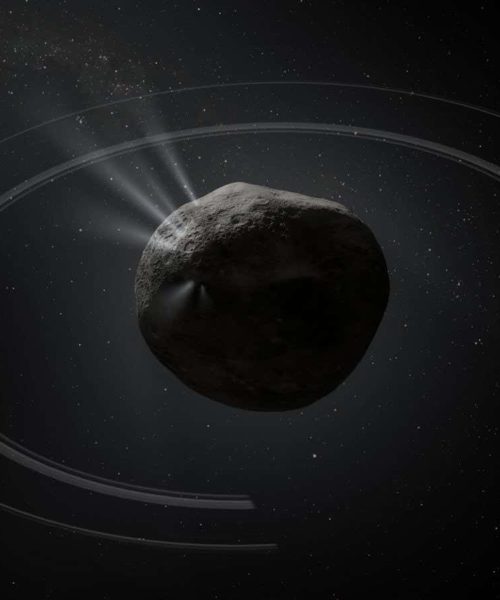
The solar system’s largest moon, Ganymede, alongside Jupiter in a picture taken by NASA’s Cassini spacecraft
NASA/JPL/University of Arizona
A massive collision billions of years ago may have dramatically reoriented Ganymede, Jupiter’s largest moon.
Naoyuki Hirata at Kobe University, Japan, and his colleagues studied Ganymede’s extensive furrow system, a series of concentric troughs believed to be remnants of the largest impact structure in the outer solar system.
Advertisement
The centre of the furrow system aligns closely with Ganymede’s tidal axis – the imaginary line running to Jupiter from the centre of the moon’s side that always faces its planet. This led the researchers to suggest that the impact that formed the furrows caused a significant redistribution of mass that reoriented the moon.
Through simulations, the researchers determined that the impactor responsible probably had a diameter of about 150 kilometres – significantly larger than the one that caused the extinction of the dinosaurs on Earth, which is estimated to have had a diameter of about 10 kilometres.
Andrew Dombard at the University of Illinois Chicago says that if an asteroid like that hit Earth, “it would be a global sterilising event, a bad day”.
Upon impact, this asteroid would have breached Ganymede’s icy crust into the liquid oceans below, creating a transient crater and hurling vast amounts of material across the moon’s surface.
As this settled, it would have formed a thick blanket of ejecta around the impact site, creating a region where gravity is stronger due to the extra mass. Over time, this anomaly would cause Ganymede to reorient, aligning the impact site with its tidal axis, the simulation showed.

Furrows on Ganymede are thought to be remnants of an ancient impact structure
NASA/JPL/Brown University
Hirata’s team compared this process with an event on Pluto, where a large impact created a basin called Sputnik Planitia, leading to a reorientation of the dwarf planet.
However, although it is likely that the Ganymede impact significantly affected the moon’s early history, estimating the size of the object that hit it is complicated because we lack good data on the gravity and topography of this frigid world, says Hirata.
Dombard says the model used in the paper doesn’t account for some of the complexities of Ganymede’s unique icy structure. “I think it is very good for establishing that this process could occur, but I don’t necessarily trust the numbers,” he says.
Topics:





